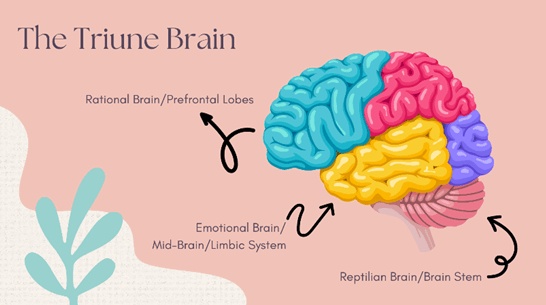The Benefits of Body-Based Approaches in Psychotherapy

There are two broad umbrellas that cover the different techniques and modalities used by therapists: top-down approaches and bottom-up approaches. Generally, more traditional talk therapies fall under the top-down umbrella while more body-based therapies fall under the bottom-up umbrella. This post is going to focus on the benefits of bottom-up (or body-based) approaches to mental health counselling and why these may be more effective for you. However, to do this, it’s important to understand the main differences between top-down and bottom-up approaches. And to do that, we need to learn a little bit about the brain (nothing too scientific though, I promise!).
The Triune Brain
 At the risk of oversimplifying the brain, we are going to break it down into three main parts:
At the risk of oversimplifying the brain, we are going to break it down into three main parts:
At the bottom, we have the brain stem, which is the first part of the brain to develop. We also call this part the Reptilian Brain. This is the part of the brain that is in charge of the functions that help to keep us alive, such as our breathing and heart beat. The Reptilian Brain is very instinctive or reactive and is primarily tasked with keeping us safe.
Moving up to the middle of the brain, we have the limbic system. We refer to this section of the brain as the Emotional Brain. You probably guessed it by the name, but this part of the brain houses the majority of our emotional functions. It also helps the Reptilian Brain in reacting to real and perceived danger and keeping us safe.
Finally, at the top of the brain we have the prefrontal lobes, or what we refer to as the Rational Brain. This is the part of the brain that develops last in life. Research used to tell us that this part of the brain wasn’t fully developed until age 25. Newer research tells us that this part of the brain is still developing into our 30s and 40s, and maybe even later! The Rational Brain is in charge of logical thinking and reasoning.
Top-Down Approaches to Therapy
Now that we have a general understanding of the brain, we can dive into the main differences between top-down and bottom-up approaches. The reason for this is that these terms actually refer to the part of the brain that we are appealing to or working with in therapy (as in the top part or the bottom part).
Let’s start by looking at top-down approaches. These types of therapy are targeting the top parts of the brain (i.e., the frontal lobes, or the Rational Brain). These therapies focus most on our thoughts as well as on language, reason and logic (again, all things housed in the top part of the brain, hence top-down). The goal of top-down approaches is typically to change how we think so that we can change how we feel. This is generally achieved through more talk-based therapy.
Some examples of popular top-down approaches include:
- Cognitive Behavioural Therapy (CBT)
- Dialectical Behaviour Therapy (DBT)
- Solution-Focused Brief Therapy
- Prolonged Exposure Therapy
- Acceptance and Commitment Therapy (ACT)
Bottom-Up Approaches to Therapy
On the other hand, bottom-up approaches target the lower parts of the brain: the brain stem (i.e., the Reptilian Brain) and the limbic system (i.e., the Emotional Brain). These types of therapies tend to focus more on body sensations and emotions as one of the primary beliefs of this approach is that a calm body equals a rational mind. Bottom-up approaches tend to incorporate more somatic (i.e., body-based) and expressive components than top-down approaches. Their aim to is help clients process memories and energy that are stored in the body, helping to signal to the brain that all is well.
Examples of popular bottom-up approaches that you may or may not have heard of include:
- Somatic Experiencing
- Sensorimotor Psychotherapy
- Eye Movement Desensitization Reprocessing (EMDR)
- Expressive Arts Therapy
- Play Therapy
Why Try a Bottom-Up Approach?
Research is showing us is that when we’re in a state of chronic stress or anxiety, the rational part of our brain actually goes offline. If you remember, that’s the part of the brain that we’re targeting the most with top-down approaches. This would make it pretty hard for more traditional talk therapy strategies to be effective if the part of the brain they’re targeting isn’t even online, right? This phenomenon is happening a lot if we are experiencing a lot of stress or anxiety, or if we have experienced some trauma. And this is definitely happening in the therapy session, when we are bringing up topics that can be triggering or uncomfortable.
Calming the Nervous System
When you are a person who tends to experience more anxiety, the brain often perceives many things in your environment as a threat, just in case. And by the time you realize what’s happening on a conscious level, your body is already doing all the things it thinks it needs to do to keep you safe. The good news is, if we can find ways to signal to our body that we are actually safe, it can send that message back up to the brain for us so that we can get back out of the stress response. And we do this by calming our nervous system.
The nervous system is kind of like our communication highway, and it’s in constant communication with our brain. An interesting statistic that I learned recently is that 20% of this communication goes from the brain to the nervous system, but 80% goes from the nervous system to the brain! This highlights the importance of focusing on the body and nervous system when working with stress and anxiety. Working with a therapist who is trained in bottom-up approaches, you can begin to learn strategies and tools that help to calm the nervous system. This will allow you to find calm and safety in your body, which in turn helps the rational mind to come back (and stay) online.





